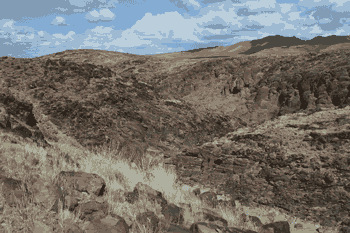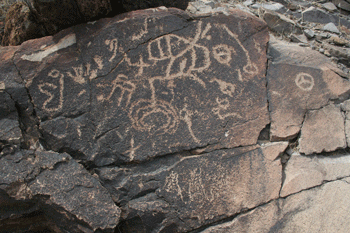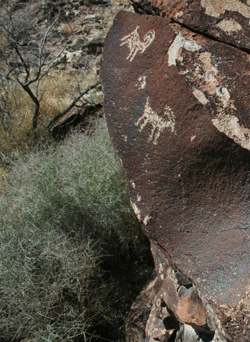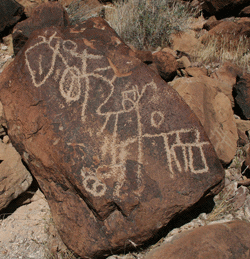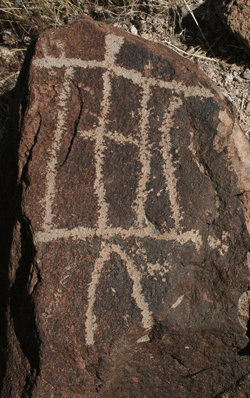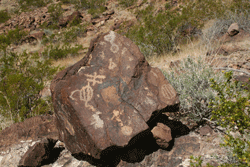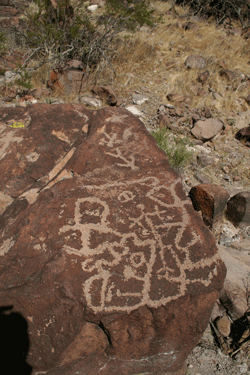Sloan Canyon NCA
To view this page as a printable PDF click here
The Sloan Canyon Petroglyph Site is a National Register-listed property in the Sloan Canyon National Conservation Area, Clark County. In 2006 the BLM had NRAF document the site to gather data that would allow a condition assessment to be made. NRAF’s report was completed in the winter of 2007 and an overview of the project is provided here.
Background
The Sloan Canyon site is located in the northwestern McCullough Range, south of Las Vegas and Henderson. The site had previously been recorded by the Harry Reid Center for Environmental Sciences (HRC) in 1997/98 and by Far Western Anthropological Group in 2004. HRC’s work focused on providing an inventory of the site’s rock art and defined its spatial characteristics and established its boundaries. Their work was supplemented by Far Western’s investigations that identified other archaeological features at the site and noted additional rock art panels, extending the northern boundary of the site.
HRC identified some 318 rock art panels at the site, distributed over approximately a mile. HRC divided the site into four sections (Lower Canyon, Middle Canyon, Upper Canyon, and Narrows). Each section was composed of varying numbers of loci. The greatest concentration of rock art panels was noted in the Middle Canyon and Narrows areas of the site, which are located midway through the canyon. Far Western supplemented this record with the identification of 14 additional rock art panels and 7 archaeological features. The results of these archaeological surveys indicate that the Sloan Canyon area has evidence of Middle Archaic, Late Archaic, Puebloan, and Late Prehistoric occupation, mainly connected with resource procurement and processing.
Recording Sloan Canyon
The objectives of the NRAF site recording conducted in spring 2006 were to produce accurate scale drawings, archival photo documentation, a GPS datalog, and IMACS records of all rock art panels at the Sloan Canyon site. In addition, public education in the form of training in rock art site documentation methods was provided to site stewards for the site.
Where possible, all previously identified rock art panels were relocated in the field and assigned the designation given them by HRC. Panels that had not been previously identified were given a numeric designation. After relocating previously recorded panels, each locus underwent pedestrian survey to identify additional rock art panels and archaeological features. Each identified panel was then documented by: a scale line drawing; photography in digital and print formats; the preparation of an IMACS rock art attachment form; and its location mapped using a hand-held GPS device.
With one exception, all previously identified panels were relocated and recorded. During our fieldwork we also observed several additional panels (both graffiti made since 1998 and prehistoric panels previously obscured by vegetation and colluvial materials) that were also recorded using the above methods. All panels were carefully examined in the field for observed changes in condition from that documented by HRC and Far Western. The condition data collected during our survey supplements the BLM’s existing programs and measures to protect the cultural resources as Sloan Canyon. Ultimately, a total of 397 rock art panels was recorded by NRAF at Sloan Canyon.
Style
Sloan Canyon’s rock art is predominantly Basin and Range Tradition in character. Abstract motifs account for about 89 percent of the 1133 motifs present. Circular forms are more frequent motif types than rectilinear designs or variants of lines. In terms of numbers of panels, though, these three broad forms occur in roughly equal quantities, but variants of lines are slightly less common. In general, there is little spatial variation across the site in the distribution of abstract motif types; i.e., discrete spatial patterning in the occurrence of the three broad abstract types is not discernible.
Some specific abstract motif types are, however, localized in their distribution. So-called “necklace” designs (two nested arcs outlined by a row of dots that follows the contour of the outer arc) are found only in Upper Canyon I. Possible “atlatl” representations are rare, but seem to be concentrated in Middle Canyon I. If these really are schematic “atlatls,” then this might indicate a Middle Archaic date for some rock art production at that location.
Overall, the abstract imagery at the site exhibits a tendency to open forms, sometimes with other motifs inside. Its opaque references probably encouraged ambiguity in the cultural interpretations attached to it by its users, perhaps indicating that it functioned to provide an exegetic space for the expression of competing social narratives, a common function of visual symbolism. Alternatively, it may have had very specific cultural meanings for its users, meanings that an external observer cannot “read” based simply on a visual consideration of its properties.
Some art may be more performative in its motivation than other types. Simple vertical lines, usually occurring singly, account for about 10 percent of all motifs at the site. As these are not related to other design elements they may be related to practices where leaving a mark was the main motivation.
Figurative forms tend to evoke greater interest from modern observers of rock art, largely because their apparently representational nature gives us a false confidence that we can identify its subject and cultural references. These motif types also bear the burden of style definitions in rock art studies as stylistic variation is easier to recognize in forms for which the apparent theme or subject can be identified.
Representational forms are statistically a small component of the Sloan Canyon rock art assemblage, only about 11 percent of all motifs but approximately 23 percent of all panels. Anthropomorphs outnumber zoomorphs in the number of panels in which these are present, but zoomorph motifs are slightly more frequent than anthropomorphs. In general, anthropomorphs tend to be represented singly in contrast to zoomorphs, a greater proportion of which are depicted with other zoomorphs.
Most zoomorphs and anthropomorphs at the site are of types that are not culturally specific. Two anthropomorphs are historic in character as they appear to be wearing cowboy hats and one is apparently holding a rifle. One other anthropomorph may be historic in age as it is depicted apparently riding a quadruped. These historic motifs may be important records of early contact between Native Americans and Euro-Americans. The remaining anthropomorphs at the site predominantly are Basin and Range Tradition stick-figure anthropomorph types.
Explaining Sloan Canyon's rock art
Although the archaeology of Sloan Canyon NCA documents the presence of Puebloan, Patayan, and Southern Paiute peoples (among others), these cultural identities seem to be only weakly expressed through the site’s rock art. If the rock art did function to construct and communicate cultural identities with external groups, it did this in a way that we cannot apprehend through its motif assemblage.
Some rock art is directly associated with milling features and the general archaeological context of the site’s art is one of resource acquisition and procurement, and temporary habitation for task-specific purposes. The informing context in which prehistoric populations would have used and encountered the site’s rock art is one of daily economic and social routines.
The art is generally not in spaces that can be considered private (other than the few panels that are up high above the canyon floor and that are difficult to access) and largely is placed in natural traffic corridors or activity areas. Therefore, it is likely that Sloan Canyon’s rock art negotiated and expressed social identities experienced in the routines of daily social life. The art may have been used in a cultural discourse that allowed people to reflect on the lived experience of social and domestic routines, providing a physical embodiment of a social memory that transcended individual experience.
Acknowledgments—We are grateful to the BLM Las Vegas Field Office for the opportunity to have participated in this project and thank Mark Boatwright, Charlie Carroll, and Lola Henio for the various support and assistance they provided during the project. Fieldwork was led by Angus Quinlan assisted by Barbara Struble and Alanah Woody.
As ever, NRAF volunteers were invaluable in the field and included: Linda Avance, Susan Bailey, Barbara Bane, Frank Bisceglia, Martha Burk, Richard Capp, Dan Clark, Kathy Clark, Kathie Clinesmith, Larry Clinesmith, Pam Cramer, Frank Crosser, Sue Crosser, Brian Curwen, Vicki Curwen, Peter Davis, Cheryl Ference, Bob Fowler, Grace Maderas, Nancy Gentis, Barron Haley, Anne Higgins, Elaine Holmes, Bill James, Darwin Johnson, Dale Kavula, Rose Keogh, Norman Kresge, Marilyn MacMurtrie, Brendan Mangan, Jona Mangan, Anne McConnell, Deb Mitchell, John Mitchell, Franco Moller, Patricia Moller, Inge Nagel, Linda Nations, Denis O’Brien, Joan& O’Brien, Alan Personious, Lynne Personious, Paula Reynosa, Rebecca Scharf, Matthew Schneider, Mary Sheets, Barbara Slivac, Jill Stovall, Jeff Thelen, Lorrie Vavak, Gary Vetter, Loretta Watson, Margaret Westcamp, Chuck Williams.
Volunteers who helped to process field drawings include; Carolyn Barnes-Wolfe, Anne Carter, Janice Hoke, Elaine Holmes, Bill Jackson, Joanne Jackson, Pan Lambert, Anne McConnell, and Laura Ouimet.


